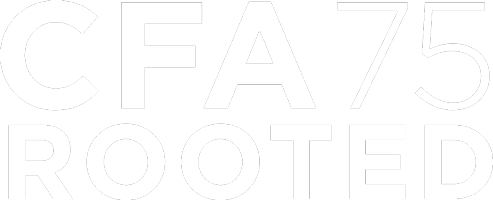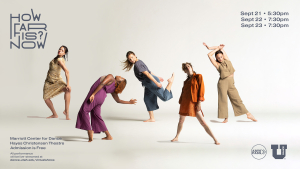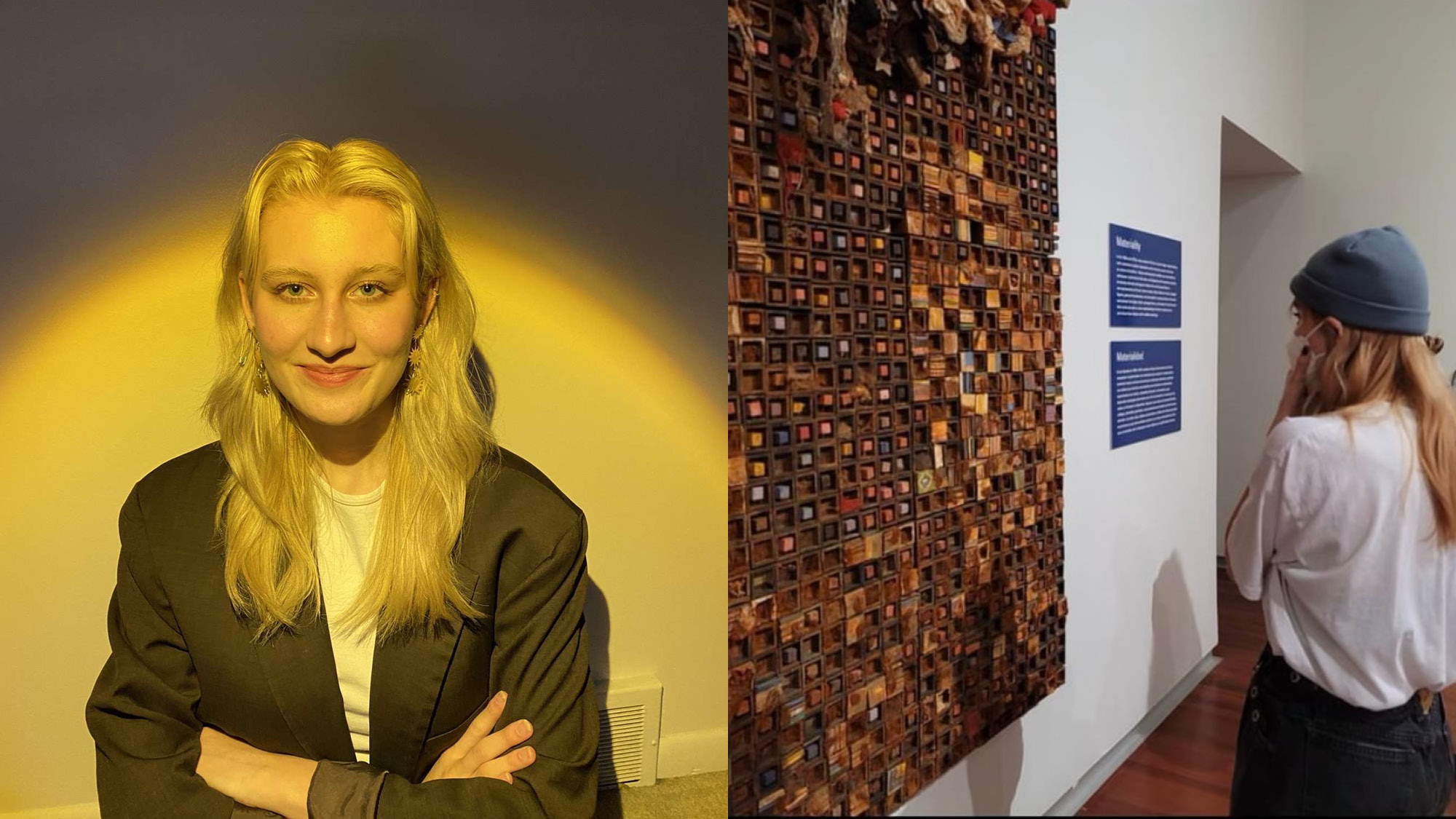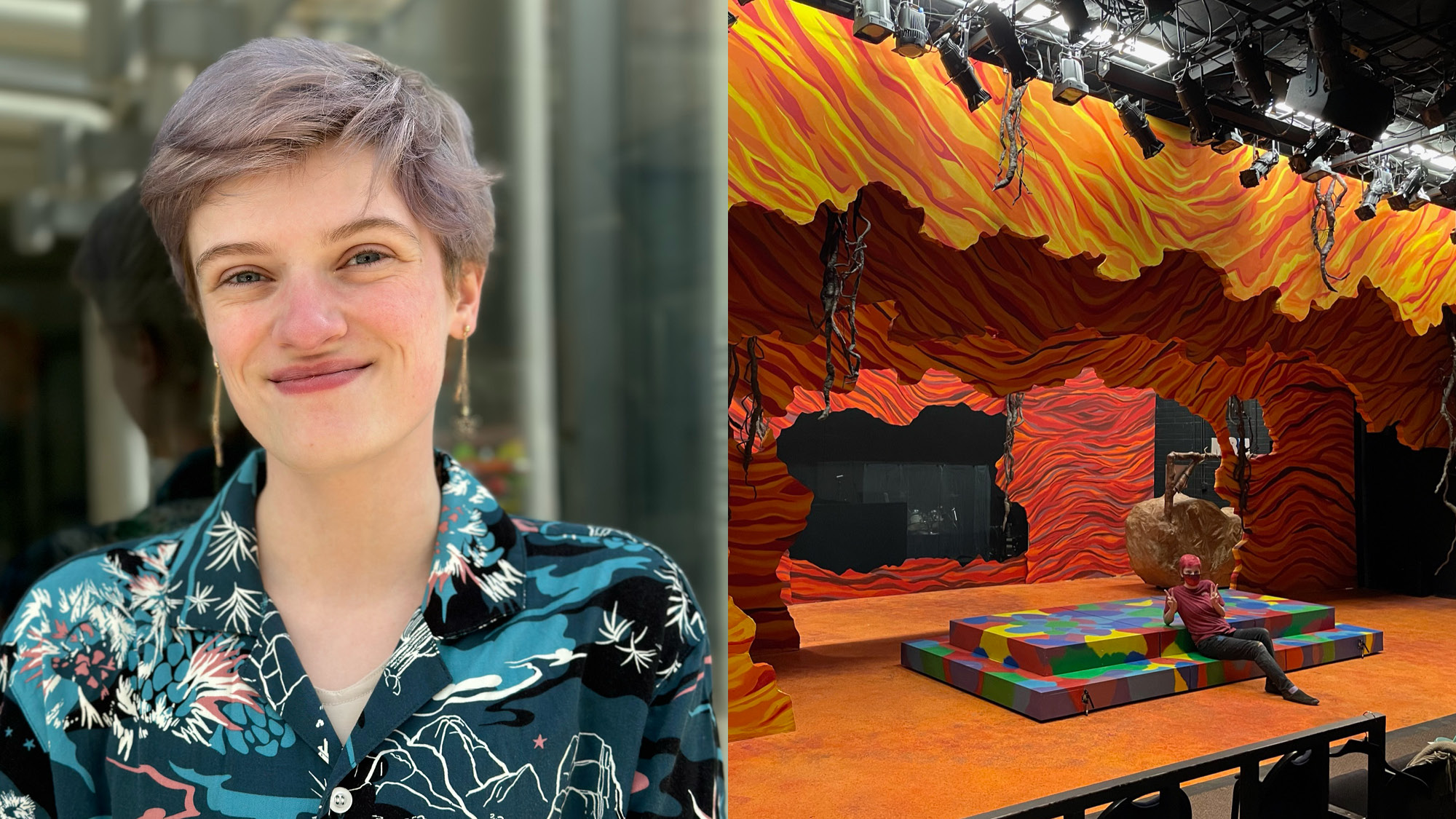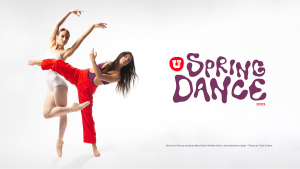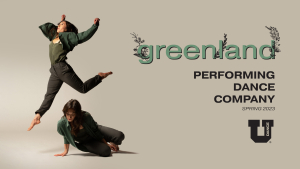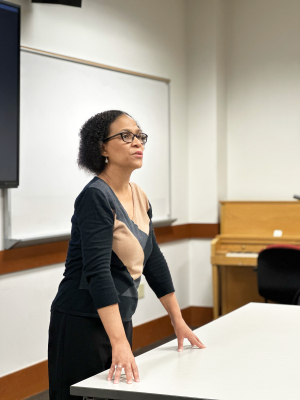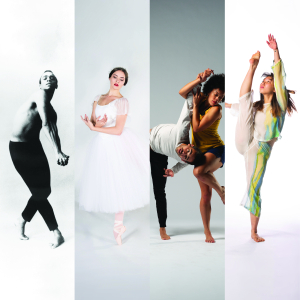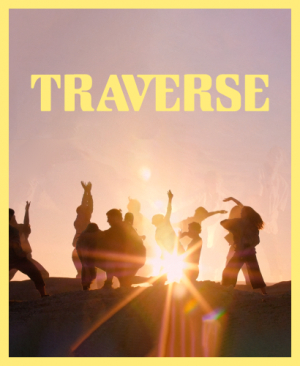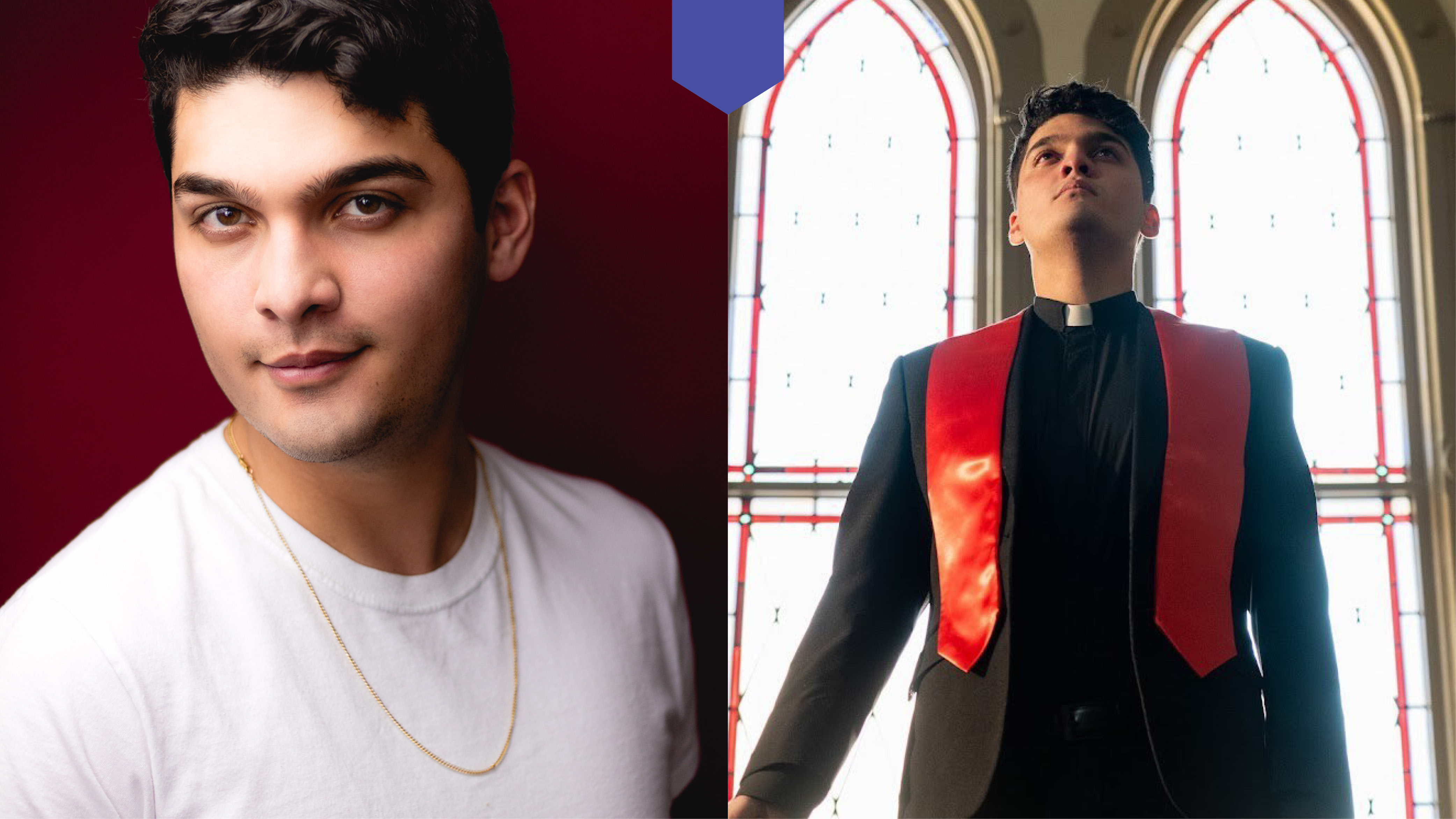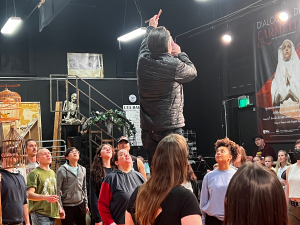Displaying items by tag: School of Dance
How Far is Now?
The School of Dance at the University of Utah presents a dance concert of thesis works from Modern Dance MFA candidates Kimberly Fulmer, Rebekah Guerra, Carly Herrmann, Irishia Hubbard, and Sam Stone. These choreographers, along with the performers, have created an evening of kinesthetic delight, alluring dance theatre/storytelling, and riveting imagery. Please join us for an evening of five unique and varied dance pieces, where the live art form of dance allows us to be present –– with each other –– now.
Kimberly Fulmer’s "Traces," initially inspired by postmodern choreographer Trisha Brown, investigates how movement can evolve and materialize in and through different bodies over time with individual embodied archives.
Based on Frida Kahlo's double-self-portrait, "Las Dos Fridas" (1939), "Bolero de lxs Fridas," a work choreographed by Rebekah Guerra, is a theatrical interrogation of how we present ourselves as the characters we are performing and how it conflicts with the narratives that reside inside us. "Bolero de lxs Fridas" is in collaboration with José Miguel Santelices, Briana Gillet, Nathaniel Skinner, Gwen Benitez, Brianne Corbridge, Zhenya Ragulin, Loren Khan, Alejandra Nelson, Kendall MacMillan, Pablo Piantino, Doug Corbin, and Satu Hummasti.
Carly Herrmann's "awaken" was created to speak for mental health within the ballet world. Exposing both the darker and blissful experiences of a ballet dancer's journey and life, awaken shows the story of the emotional struggle and joy ballet dancers encounter day-to-day within themselves.
Irishia Hubbard’s "Unearthed" explores the unwritten history of Black moving image arts by analyzing Africanist Aesthetics in American dance, photography, and film.
Sam Stone and dancers bring original music and choreography in their indie-punk band turned dance theatre performance, "Hers to Give." Six women wishing, hoping, caring, waiting… scratch that: Six women together, wanting and getting. Engage, enrage, move.
Be here with us.
September 21st at 5:30 pm
September 22nd at 7:30 pm
September 23rd at 7:30 pm
In-person at the Marriott Center for Dance, Hayes Christensen Theater, 330 South 1500 East,Salt Lake City, UT 84112.
Free admission, limited seating at the door. Live streaming at dance.utah.edu/virtualshows
The College of Fine Arts is delighted to present the 2023 Outstanding Seniors from each of our five academic units.
These individuals were nominated for their academic achievements, artistic and scholarly accomplishments, and ongoing commitment to their craft. We are inspired by each of them, and look forward to witnessing the ways they continue to contribute to our community. We are honored to have shared their time here as students.
Congratulations!
Avery Greig
Department of Art & Art History
Pronouns: She/They
Majored in: Art History Major with a Diversity Certificate and a Business Minor
Hometown: I was born in Detroit, Michigan but moved to Utah from Boston, Massachusetts which I consider my second home.
Three words that describe you: Driven, Visionary, and Open-Minded
Most impactful class or professor: My most impactful professor at the U has been Professor Sarah Hollenberg! She is a wonderful professor who urges her students to think about varying perspectives — which has greatly impacted the way I think as an undergraduate student. I really enjoyed working with her when I was the President of the Art History Student Association (AHSA), of which she was our faculty advisor and truly helped me reach for cool opportunities and get out of my comfort zone. I loved taking her Museum Practices course in which every member of the class was assigned a museum job position and as a class we created our own museum together. I will never forget that.
A CFA moment you’ll never forget: I will never forget taking group trips to the UMFA with the Art History Student Association!
What inspires you: Inspiration surrounds me constantly! I find little bits of inspiration all around me. I am greatly inspired by visual art and music — if you see me walking on campus, I always have my earbuds in and my head in the sky, looking at trees and plants or the shapes of the buildings on campus. Music and visual art really inspire me in my writing in the Utah Daily Chronicle, often when I find myself stuck I will turn to various forms of art media to get my writing flow back. My brilliant mother, strong father, and hard-working brother all inspire me and support me to reach my goals each and everyday, and I am inspired greatly by my beautiful and creative friends who push me to reach for big and bright things.
Summary of major accomplishments on or off campus: I was a pre-professional ballerina at the Boston Ballet when I was in high school, President of the Art History Student Association at the U and Arts Desk Editor at the Daily Utah Chronicle. In my time as AHSA president, I co-organized a successful three part professional lecture series centering on underrepresented voices in the art world, bringing in professionals to talk to university students. Last year, I was awarded 1st Place for Best Arts Writing for the University of Utah’s Student Media which was a big honor. I also held an internship with the Utah State Department of Arts and Museums where I worked directly with the state art archive. I am extremely honored to be named this year's Art and Art History Department Outstanding Senior.
Hopes and plans for the coming year: This coming year, I am hoping to transition into an archival-based job position while I start planning for graduate school! I am planning on pursuing a Masters in Library Sciences graduate degree. Additionally, I plan to travel around this summer, including a trip back home to Boston and to Florence, Italy!
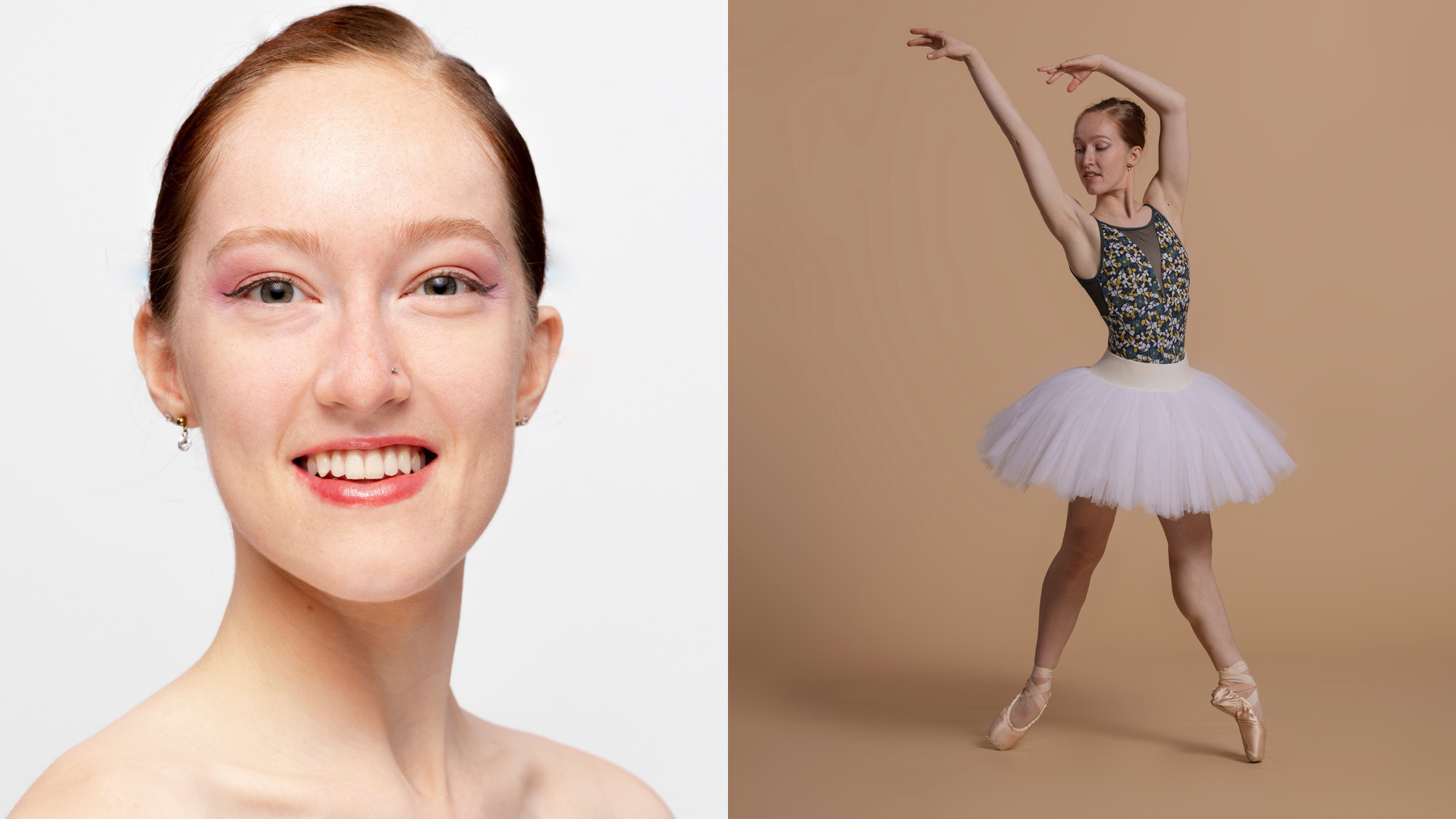
Megan Lynch
School of Dance
Pronouns: She/Her
Majored in: Ballet BFA, History BA
Hometown: Winona, Minnesota
Three words that describe you: Dedicated, passionate, optimistic
Most impactful class or professor: It is difficult to narrow it down to one person, but I find that Pablo Piantino is woven throughout my entire four years in the School of Dance. He has simultaneously challenged and encouraged me to be my most authentic self, and exude excellence both on and off stage, inside and outside the classroom. I also find that Christopher Alloways-Ramsey, Justine Sheedy-Kramer, and Maggie Tesch, who have advocated for me and mentored me over the years are also essential to my success.
A CFA moment you’ll never forget: During my first performance with the School of Dance, the entire cast I was performing with got a card and signed it to encourage me. It taught me the importance of creating a community that cares and supports each other, and how a small act of kindness and encouragement can make such a large impact. I still have the card to this day and make a point to do similar acts for my peers.
What inspires you: I am inspired by kind and passionate people in any area of study, willing to share that passion with others.
Summary of major accomplishments on or off campus:
- Merit Scholarship, Ballet Department
- Service Scholarship, College of Fine Arts
- Ungraduated Research Opportunity Program (UROP) scholar and grant recipient
- Research Assistant, Professor ShawnaKim Lowey-Ball, History department
- President of Character Dance Ensemble (2022-23), Vice President (2021-22), Member (2019-2023)
- Vice President of Student Dance Exposure Committee (2021-2023)
- Student Advisory Council (SAC) co-president, School of Dance, Ballet Department Representative
- FAF grant council committee member
- Performed in numerous mainstage performances with the School of Dance, including Kitri in "Don Quixote," Princess Florine in "Sleeping Beauty," and Alejandro Cerrudo's "Second To Last," as well as many other original works by faculty and guest artists.
- Performed in, and choreographed for, peer-directed performances.
- Studied during the summer months with the Joffrey Ballet, Kansas City Ballet School, Utah Ballet Summer Intensive, and International Summer Program in Incheon, South Korea
Hopes and plans for the coming year: Dance professionally in a ballet company, and continue to foster a supportive community, wherever I am.
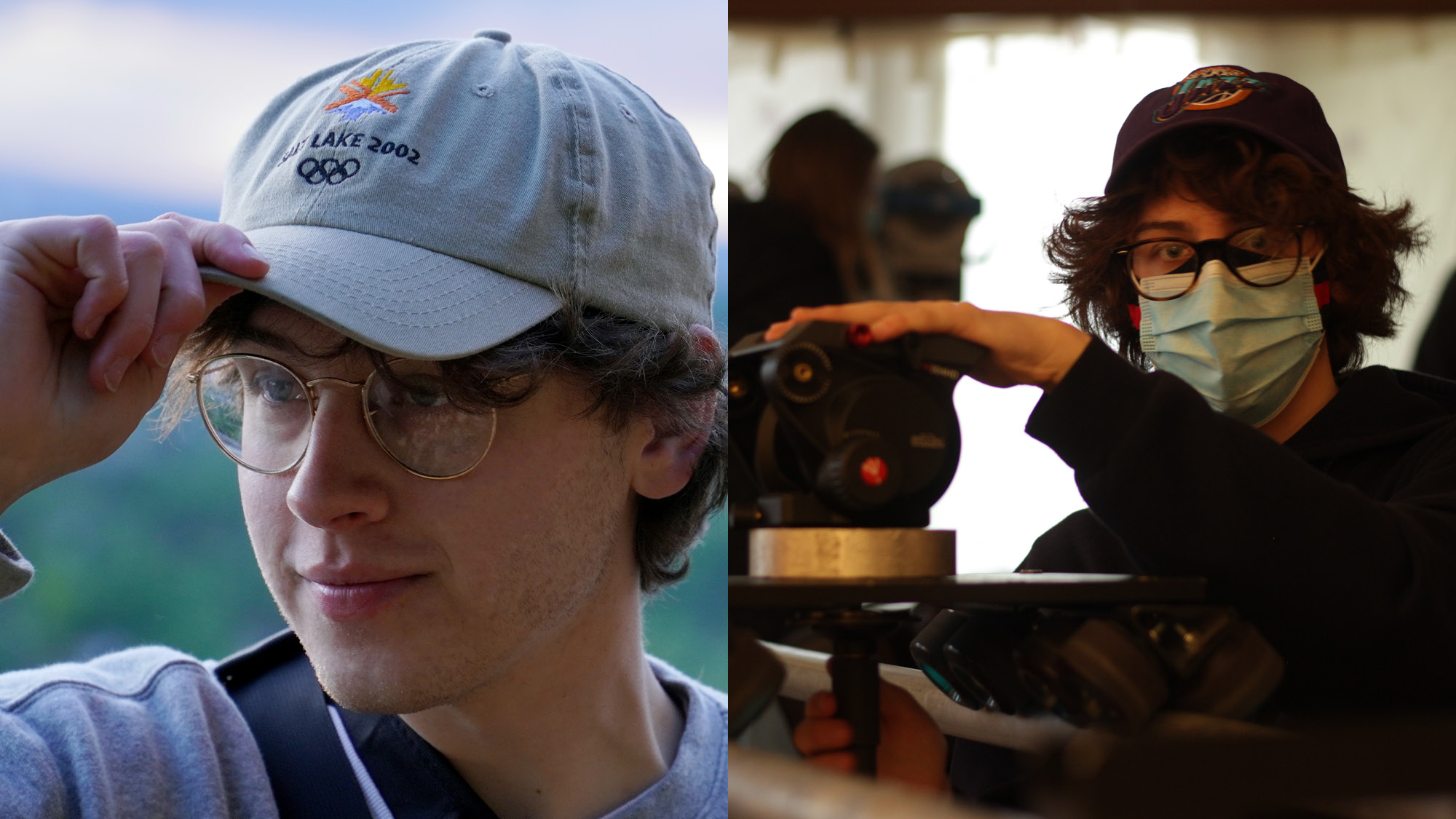
Cayden Turnbow
Department of Film & Media Arts
Pronouns: He/Him/His
Majored in: Film and Media Arts
Hometown: Salt Lake City, UT
Three words that describe you: Leader, Motivated, Creative
Most impactful class or professor: I've had the privilege of taking Paul Larsen's screenwriting class for the last couple of years and have learned so much about how to take and give criticism, how to create a compelling story with interesting characters, and how to maintain self-discipline when writing longer form scripts. Paul Larsen without a doubt has been one of the most impactful professors while I've been at the U and I'll be sad to say goodbye when I graduate.
A CFA moment you’ll never forget: When Lee Isaac Chung visited campus I went to almost every single one of the events he attended and took scrupulous notes. It was his advice that inspired certain aspects of my capstone. He encouraged me to take risks and keep chasing my goals even when times get tough.
What inspires you: I find that it's the people closest to me that inspire me the most.
Summary of major accomplishments on or off campus: I co-founded the Film Production Club and as its president produced and co-directed a short film titled "My Baby" which received a distribution award at the 2022 Spring Showcase. "Toothbrush" is another film that I directed that premiered alongside "My Baby" last year. I've received an Epics award through ADTHING (an advertising agency for which I am the current Video Director) for a commercial I made for Tacos Don Rafa. I've had the privilege of being an RA for the Fine Arts Floor, and a resident of the Fine Arts House. As an Emerging Leaders Intern, I helped organize the 9th annual ArtsForce Networking Event and had multiple articles published in the Finer Points Blog. Last summer I had an internship with Blank Space, a rewarding experience supported by the Utah Film Commission. Shortly after I joined Slamdance as an intern and worked up to managing the online festival in 2023.
Hopes and plans for the coming year: I hope to be able to continue to create, in whatever aspect that may be, as well as find a job that will be a stepping stone for my career in the film industry.
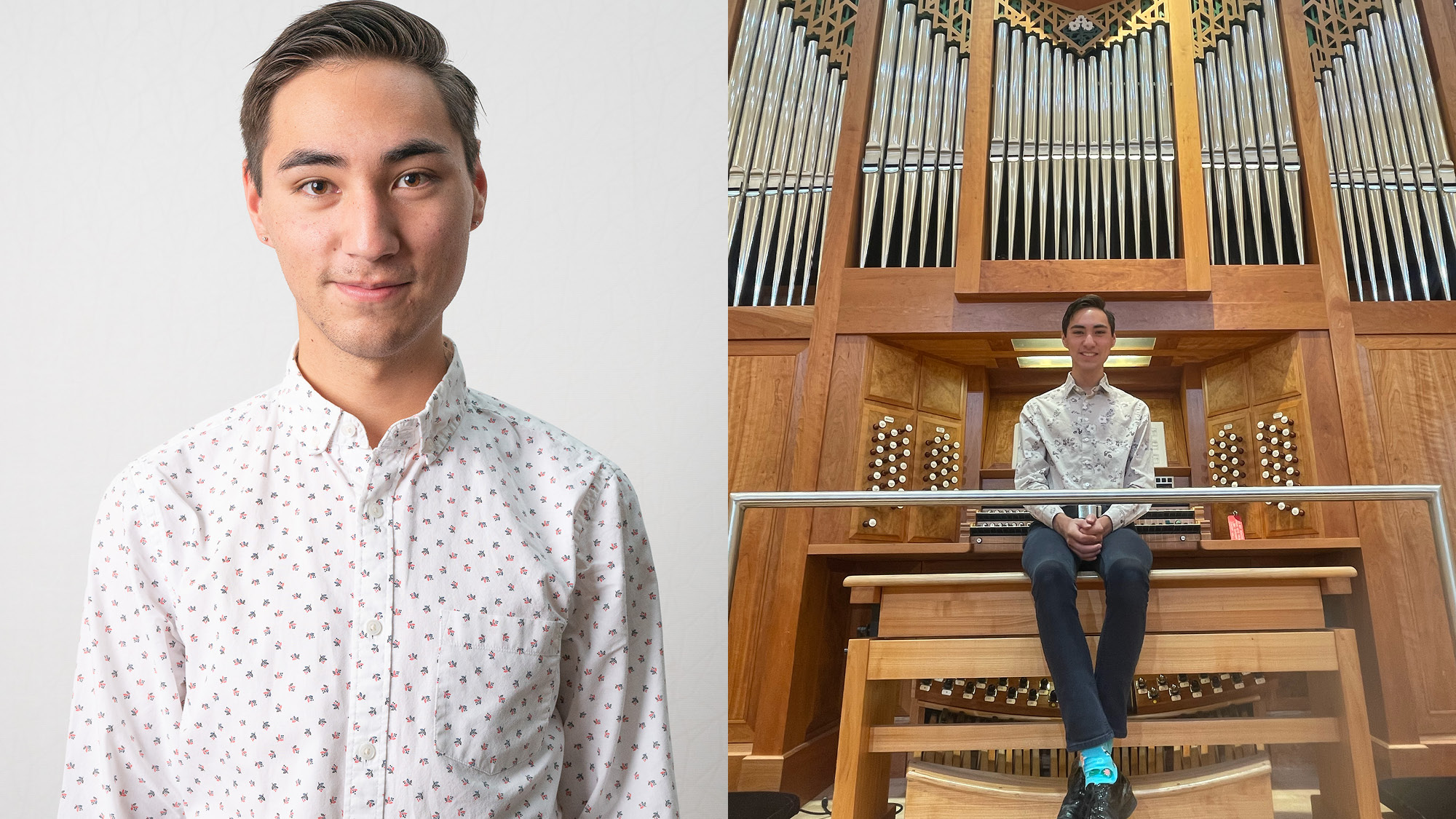
Samuel Judd-Kim
School of Music
Pronouns: He/They
Majored in: HBA in Music and HBS in Philosophy
Hometown: Orem, Utah
Three words that describe you: Tenacious, authentic, disruptor
Most impactful class or professor: If I have to choose just one, it would be Dr. Pamela Jones, for picking up on and nurturing my enthusiasm for learning (both before and during the pandemic), mentoring me on the harpsichord, and directing me toward so many amazing opportunities! However, I would also like to recognize Dr. Ken Udy and Dr. Haruhito Miyagi for their generous support and wisdom.
A CFA moment you’ll never forget: Playing harpsichord continuo with the Utah Philharmonia on a few concerts; as a keyboardist, I always relish the chance to play with an orchestra. An honorable mention would be playing the Libby Gardner Concert Hall organ for the very first time.
What inspires you: All of the talented and visionary artists I’ve had the pleasure of working with; I’m incredibly lucky to have collaborated with so many driven musicians who motivate me to keep doing music.
Summary of major accomplishments on or off campus:
- Two solo organ recitals at the Cathedral of the Madeleine (Salt Lake City) in 2020 and 2022.
- Original senior honors thesis: “Queering the Pipe Organ,” a musicology paper supervised by Dr. Haruhito Miyagi.
- Many joyous collaborative performances on harpsichord and organ, with amazing flautists, harpists, strings, chamber groups, and orchestras.
- With the College of Fine Arts advising team, assisted incoming Fine Arts students as a Create Success Intern
- Helped found the University of Utah Asian Collective, which is working with the Office of EDI to create an Asian Cultural Center on campus and advocates for Asian and Asian-American communities on campus.
- Created workshops on sexual violence prevention for queer students, students in Greek life at the U, and high school students, both as an intern at the Rape Recovery Center and as student staff at the McCluskey Center for Violence Prevention.
Hopes and plans for the coming year: Taking a gap year to explore how to apply the knowledge and skills I’ve learned in the School of Music in an impactful way in my communities. I hope to eventually attend graduate school and build on the research in queer musicology I engaged in for my honors thesis, while always keeping sight of the reasons I do music!
Abish Noble
Department of Theatre
Pronouns: She/They
Majored in: Theatre, Performing Arts Design Program with emphasis in Set Design; minor in Japanese
Hometown: Yokota Air Base, Tokyo, Japan
Three words that describe you: Passionate, Detail-Oriented, Overachiever
Most impactful class or professor: Scenography Lab where I was so excited to assist in building the sets and I realized that I wanted to work in the design part of the theatre world.
A CFA moment you’ll never forget: In scenography lab, I painted a mechanical snake to be used in our production of Men on Boats. That was when Halee offered me a work-study position, and how I could work directly in the shop.
What inspires you: The ability to create amazing things with amazing people.
Summary of major accomplishments on or off campus: Co-set designed the U’s first virtual production in 2020; The Night Witches. I also set designed Storm Still in 2021, and my work was featured in the CFA gala. I was the Scenic Charge Artist for Naked Mole Rat Gets Dressed: The Rock Experience in 2021, and Liminal in 2022. I finished my college career with my set design of the new musical; In Pieces. I have also done some volunteer work off campus for the Utah Pride Festival.
Hopes and plans for the coming year: I plan to continue to work in theatre here in Salt Lake, and hope to work full-time as a theatre technician.
During the last few months, the School of Dance has been a bustling hub of creativity. Coming off a tremendous high after the wonderful run of Performing Dance Company’s greenland, our dancers are ready to take the stage once more. Spring Dance, happening February 23rd to the 25th, will showcase 4 world premieres that promise to engage, inspire, and entertain. The concert includes work by two of our own esteemed faculty members, Melissa Bobick and Molly Heller and two guest artists, Suzanne Haag, Eugene Ballet’s Resident Choreographer, and internationally renowned artist Rena Butler.
From pure classical and neo-classical lines to broad and expansive physicality, Spring Dance will have a vast range of choreographic voices generating an eclectic display of virtuosity and energy beautifully showcased by our talented School of Dance students.
Rena Butler is a force of nature and one of the most sought-after creators of our time. In a relatively short time, she has danced, collaborated and choreographed with some of the most renowned companies around the world. When asked about her new choreography for the School she explains: “Off Shore is a collaborative exploration of symbiosis between the water in and out of us, reflective in a series of tumultuous emotions. Up to sixty percent of the human body is water, and seventy percent of the earth is covered in water. How can one move freely with the intersection of swells and various degrees of currents to find the shoreline again?”
Guest choreographer Suzanne Haag created an exquisite design of patterns and precise movement that shifts and shapes much like a kaleidoscope. In her own words: “Ornament is a non-narrative ballet, and though there is no storyline, Fanny Mendelssohn’s emotional sound evokes relationships between the artists on the stage.”
“The title, Ornament, is taken from a quote about the sibling composers Felix and Fanny Mendelssohn, spoken by their father: “Music will perhaps become his [i.e. Felix's] profession, while for you [Fanny] it can and must be only an ornament." Despite these harsh words, Fanny Mendelssohn’s music, much of which had originally been credited to her brother Felix, has been rediscovered to be appreciated by today’s audiences.”
“My hope is that this piece presents something beautiful, something seemingly ornamental, but that ultimately it gives the audience a sense of connection as heard through the music and seen through the artists’ relationships on stage.”
Through her neoclassical and powerful movement, Assistant Professor Melissa Bobick is presenting Vox Feminae, created as an artistic collaboration with the dancers from her cast. “The work grew out of discussing the difficulty we often confront when trying to speak up and voice a personal opinion in a public forum. For us, as women who have trained in the historical framework of classical ballet, the challenge of finding our voice can be uniquely difficult. Within traditional ballet training, there are few opportunities for students to voice personal thoughts or opinions. Rather, they are instructed and encouraged to find comfort and routine in silently taking direction. I am hopeful, with a new generation of dancers, that this expectation is slowly changing.”
“In this new work, I am looking for the dancers to embody a sense of urgency. This is a physical representation of the overwhelming emotion we often feel when, in real life, we seek within ourselves the confidence to speak up. This can be true in either the dance studio or the professional world. My hope for this new generation of female dancers is that they will, with the support of one another, see the value inherent in their own thoughts, opinions, and perspectives, and, with that value in hand, bravely and confidently share their valuable insights with the world.”
Assistant Professor Molly Heller brings to us a work that swirls with energy and dynamic movement. In her own words she says: “Robust and charged, my new work, Promise the Moon, creates ongoing cinematic states within an orchestral soundscape. Eight performers interweave between internal and collective drive, curiosity and fixation, and confrontation as it meets change. This work asks, how do we know, what we know? Promise the Moon blurs hope and realism and promises to be BIG.”
Spring Dance promises to be a memorable experience for anyone interested in dance performance and music interpretation through movement.
Come join us, you will not regret it!
Showtimes:
Feb 23 at 5:30 p.m. (in person or streamed online)
Feb 24 at 7:30 p.m. (in person or streamed online)
Feb 25 at 2:00pm and 7:30 p.m. (in person or streamed online)
Marriott Center for Dance - Hayes Christensen Theatre
In-person tickets can be purchased at tickets.utah.edu for all dates.
Free for University of Utah students with a valid UCard through the Arts Pass program.
Patrons can also stream all performances live for free.
When dance brings us home
Enter this grassy liminal space where a sense of home is familiar, but shifting, in the premiere of greenland.
Starting off 2023, the School of Dance season continues with greenland, Jan. 26-Feb. 4, 2023 in the Marriott Center for Dance. This is the first-ever evening-length collaborative dance work created by five School of Dance faculty artists: Daniel Clifton, Natalie Desch, Pamela Geber-Handman, Eric Handman, and Satu Hummasti.
greenland explores how a sense of mass and scale contrasts with the minute and intimate. It’s the macro and micro of our impact — on land, each other, community, and time — through the abstraction that comes with large groups of people moving through space together. This work begs the questions: what does it mean to come home when a sense of home and space is always shifting? How do we take care?
Not only does greenland have a cast of 37 performer/collaborators from the School of Dance Modern Program and five choreographers/directors, it also features a brand new original score by Clifton, original costumes by Costume Shop Director, Christopher Larson and the MDC Costume Shop, and a very grassy original set constructed by Technical Director William Peterson and the MCD Production team, and original lighting design by Production Director, Em Bertelli.
Step into something distantly and dynamically familiar with greenland.
Showtimes:
Jan 26 at 5:30 p.m. (in person or streamed online)
Jan 27 at 7:30 p.m. (in person or streamed online)
Jan 28 at 7:30 p.m. (in person or streamed online)
and
Feb 2 at 5:30 p.m. (in person only)
Feb 3 at 7:30 p.m. (in person only)
Feb 4 at 7:30 p.m. (in person only)
In-person tickets can be purchased at tickets.utah.edu for all dates.Free for University of Utah students with a valid UCard through the Arts Pass program.
Patrons can also stream the first week of performances live for free. Jan 26 @ 5:30pm | Jan 27 @ 7:30pm | Jan 28 @ 7:30pm
For more information on the School of Dance and its concerts, please visit: dance.utah.edu.
The Black experience in ballet, which certainly isn’t singular but is an area of important inquiry, is one Joselli Deans knows well. A dancer for over a decade in Dance Theatre of Harlem under the direction of Arthur Mitchell, and an accomplished dance historian and consultant, she knows this vital history firsthand.
We spoke with Associate Professor Deans, who has recently joined the University of Utah School of Dance, bringing incredible depth of knowledge and experience to our classrooms and studios.
This informal conversation was too rich to condense, so this time, we’re sharing the nearly full transcription with you.
Emeri Fetzer: Let’s start with your early childhood interests and how you discovered dance.
Joselli Deans: I grew up in Brooklyn, New York. I have a Haitian background — my parents, Rene Audain and Anna Cassagnol Audain, are from Haiti. My mother tells me that I stood on my toes all the time. She doesn't know if it was to get out of the crib, or if it was the start of the dancing. There was a lot of music and social dancing at home.
When I was five, my cousin was taking my second cousin (who was a year older than me) to ballet class and said to my mother “Why don't you bring Joselli?” She quit three weeks later, and here I am.
My father had been an actor in Haiti. There was a great influx of Haitian people in New York City in the late 60s because of the political situation with [Hatian politican François Duvalier] Papa Doc. He felt like there needed to be entertainment for them, particularly since many of them were not yet English speaking.
He got a bunch of his acting buddies together from Haiti and started a company, called Theatre Choucoune. I was 7. They did some known plays by Molière, some Haitian plays, and he also wrote his own. Soon, he decided that wasn't enough. He was not a dancer, but he became the executive director to the dance part of the company. He got a choreographer to come in and be the artistic director for the dances.
So, my training started with three folds: I did Haitian dancing in my father’s company, tap, and ballet — so I had the European, the African-based, and the hybrid all between the ages 5 and 7.
Lillian Roberts, who owned the Utica Academy of Music and Dance where I started, asked my mother if I would do Haitian dance in my first recital. One of the women in my father's company taught me a solo, and I did it. My first recital was at the Brooklyn Academy of Music at the age of 5.
Fetzer: How did you get connected with the Dance Theatre of Harlem School?
Deans: My father discovered we had a neighbor named Charles Moore. He was a famous modern dancer, and he lived a block over. He guested at my father's company. As the only child in the company, I used to do the little solo numbers so people could change into the next number.
Charles and his wife, Ella Thompson Moore, saw me dance and thought I was talented. My mother and I ran into Ella on the street (she’s still with us by the way, living in NYC. She’s 92!). She asked what I was doing. At that point, my mother had pulled me out of the dance school because I was spending my entire Saturday there, and it was lots of costumes, three recitals a year, and lots of money.
Ella said, “Well, why don't you take her to Arthur [Mitchell] up at Dance Theatre of Harlem. He just started a school.”
My mother would ride with me on the subway. I started in the summer — I think I went three times a week during that summer. They were still at the Church of the Masters. The following year, they moved up to 466 W 152nd street. I was one of the first to be in the new building.
I was, as he used to say, dependable, consistent, disciplined, and worked hard. I wasn’t as flexible as ballet dancers should be. I was quick. I turned well, I could jump. I learned quickly.
Fetzer: What are some of the favorite moments from your time there?
Deans: Dance Theatre of Harlem started a short-lived (maybe three years) junior company that I was in — so that was quite a thing. And we did some special performances with the company and without them. One of our big performances was at the convention center in Atlantic City where they used to have the Miss America pageant. We performed for the Urban League. Celeste Holm was there, Ruby Dee was there, all these famous people – I have all their autographs in a little book I kept with me.
And then we had a command performance in the dance studio for her Royal Highness Princess Margaret and her husband Antony Armstrong Jones, Earl of Snowdon. He was a photographer, and he took a lot of pictures of the company in the early years.
Another moment was when Miss Tanaquil Le Clercq, who was Balanchine’s last wife, got polio.
Mr. Mitchell was in New York City Ballet with her when she was dancing, and he convinced Mr. Balanchine that she should come and teach at our school. So, she taught in a chair and I used to demonstrate for her in the classes. She and I both spoke French, and she would speak to me in French — I think that empowered her in some ways, because she couldn’t dance anymore. I was very honored to be her demonstrator.
I liked watching the older dancers. I remember sitting on a step there into the studio. We were allowed sometimes to come in and sit there and be very quiet and watch.
I watched incredible dancers.
Fetzer: How did you end up transitioning to the company?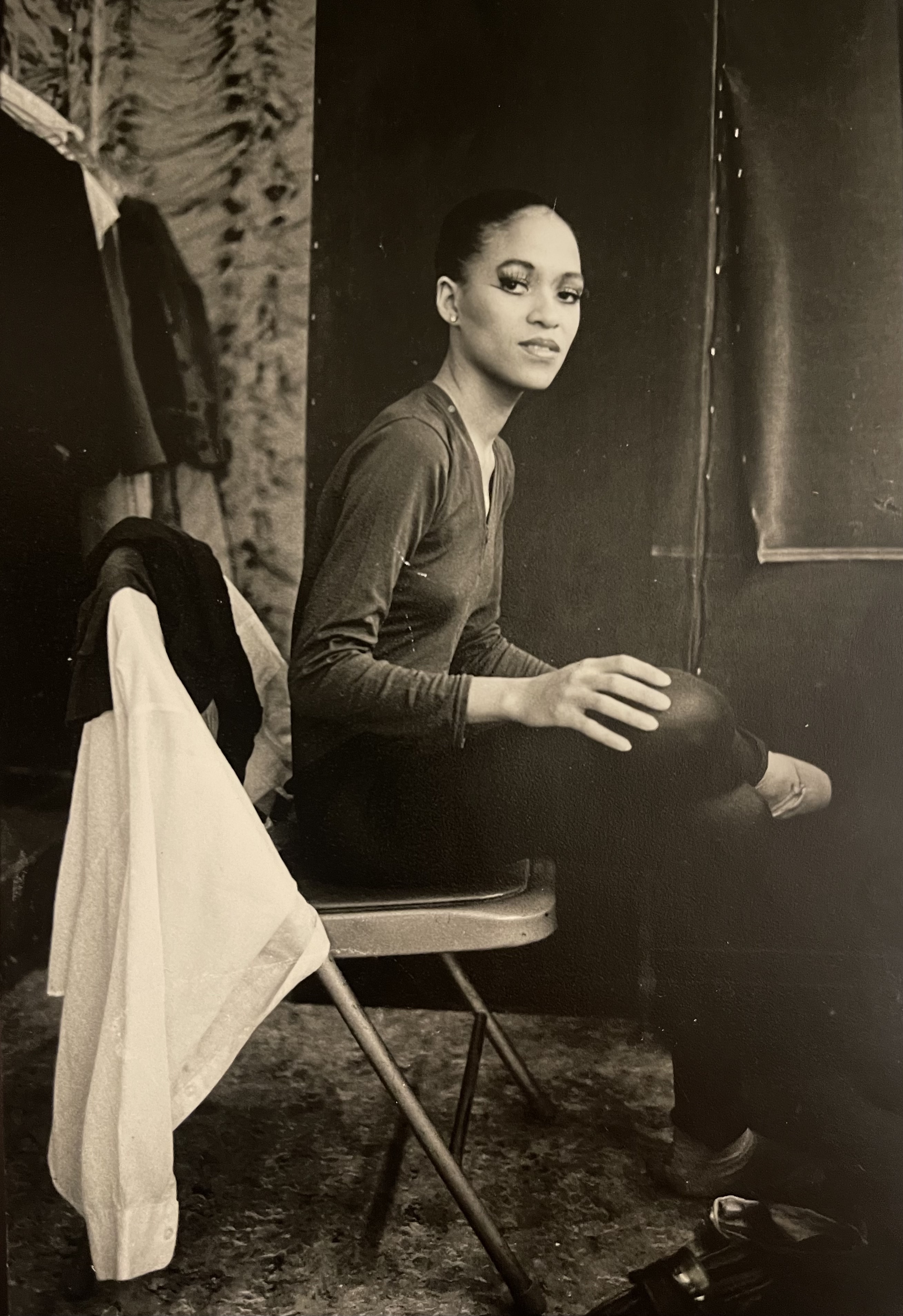 Dressing room at New York City Center 1983 | photo courtesy Joselli Deans
Dressing room at New York City Center 1983 | photo courtesy Joselli Deans
Deans: I got to the highest level that there was for school students. We had class for two hours a day, every day. I was hiking from high school in Brooklyn to Harlem every day for a two-hour class and back. I consider myself the Forest Gump of Black dance. I just happened to be in the right place at the right time. When Mr. Mitchell was putting together a special class of people, he wanted apprentices.
I walked through the office and he said, “Oh no you can't, because you don't get out of school early enough.”
I said, “I'm a senior. I get out at noon.”
“Can you be here by 1:30?”
I said, “Yes, I can.”
So, in my senior year, I performed in DTH’s first City Center season. I only did two ballets, but that's okay. That's a good start. At the end of that school year in July, the company was going to England and Ireland. I was sort of iffy – the company was an ensemble company, around 30 dancers, but he was starting to expand. I went, but I also helped with the wardrobe as an extra hand.
I was the standby dancer. One night, our lead dancer in “Serenade,” Lorraine Graves, got sick and then somebody had to take her spot. So, I had to go into the corps to replace the girl that was becoming the lead, Karlya Shelton. We didn't use titles, but in ballet terms, she was the highest of the corps. In this dance she did all the extra stuff.
My first performance of “Serenade,” I didn't even get a rehearsal. I got a look through on the video. I knew the steps because I was an understudy, but I had to learn her spacing. It was a lot of pressure. But I got through it. I made a big mistake, but I fixed it. And Mr. Mitchell was very impressed. I said, “I'm sorry I missed the cue.” And he was like, “No, but you fixed it.” I got his attention.
I just worked my way up. I was a corps dancer. I was not particularly fantastic in any way. I was, as he used to say, dependable, consistent, disciplined, and worked hard. I wasn’t as flexible as ballet dancers should be. I was quick. I turned well, I could jump. I learned quickly.
Fetzer: Of course, it is hard to cover all the amazing memories in your 11 years dancing at DTH. But can you share a few highlights?
Deans: DTH was a traveling company — a lot of ballet companies now are not. But DTH was on the road all the time, and so in the 11 years I went to 33 countries and five of the seven continents.
I danced on some of the major stages in the world: the Royal Opera House, the Kennedy Center, the Civic Auditorium where they used to have the Academy Awards before they built the Kodak. Théâtre du Châtelet in Paris…
And this is not necessarily famous, but one of my favorite movies as a little girl was “Sound of Music.” I danced on the stage at the end of the movie. I couldn’t believe I was on the stage where Julie Andrews sang. We danced at an amphitheater that Herod from the Bible built is Israel, the Met in New York, and the 1984 Closing Ceremonies of the Olympics in LA.
Fetzer: Who were some important mentors?
Deans: Well, my father was a great influence. Not so much for my dancing itself, but for understanding history. Our apartment had a long hallway lined with bookshelves. I was a reader when I was a kid. He bought me books all the time, and some about dance. I got this historical sense. And then because DTH was “the first permanent Black ballet company,” I really had a sense of history.
Mr. Mitchell, of course, was a mentor. He pushed me. He saw something in me I didn't see in myself. He said that I would be a great teacher. I must have made an ugly face when he said that. Because back in those days, the adage in dance was, those who can't, teach. I was hurt. He said, “Why is it that when I say you're gonna be a good teacher, you hear I'm saying you are a bad dancer? That’s not what I am saying. What I'm saying is you have a gift, and you need to hone it.”
In 1986, the company was invited to tea at Buckingham Palace, but there were too many of us to go. So, he only took the principal dancers, which made sense. But he or the principal dancers would teach the warmups. With them all gone, who’s going to teach? So, he comes in to teach class that morning and goes, “Okay, I'm going to Buckingham with the principals, Joselli's teaching the warmup tonight.” He didn't ask if I could do it, just did it. So, I started my teaching career with warmup for the Dance Theater of Harlem. I was in awe.
Another influence is a man named William Griffith. We called him Mr. Bill. He was the company teacher from 1980 to 1985. He very much made me the technical teacher that I am. The way I teach from him.
And Kathy Grant, a woman that learned Pilates from [Joseph] Pilates himself. She was DTH's first company manager, and she also taught special exercises, which were based on the Pilates mat work, but she added dance movement. Because I was not flexible, she helped me get the range that I needed to survive as a dancer.
Many of the dancers who got injured would wind up going to her. She would teach me how to do the therapy for them when we would go on the road. Her studio was in Bendel's department store, which was a very swanky place on 57th Street in NYC. She made a deal with my parents. We just paid the store fee and then I would come in on Saturdays, do my workout, but help her when she needed an extra set of hands.
Dance Theatre of Harlem was on the road all the time, and so in the 11 years I went to 33 countries and five of the seven continents.
Fetzer: How did you end up going back to college and on to earn your doctoral degree?
Deans: When I graduated high school and got into the company, I was also going to NYU. There was a program called University Without Walls and I would get credit for my dancing.
I did that for a year and a half. My grades weren’t great, and it was costing a lot of money. I didn't feel like I was getting what I needed out of it. I contemplated quitting.
One of my professors, Sharon Friedman, said, “Look, Joselli, you have an opportunity that dancers would die for. You're dancing with a major company. You're smart, you're hardworking, you're curious. You can always go back to school.” I decided to stop. I went home and I told my father I was quitting, and he hit the roof. It was always a given that I was going to college.
He died in 1986. I left dancing almost in 1990. So, he doesn't know that I went back to school and went as far as I did. I know he would've been really happy.
I am my mother's only child. I was always on the road — that was hard on me, and her.
And then having relationships. I never dated at work. I don't believe in that. If I wanted to get married and have kids, I was getting older. My body was hard to deal with. So I decided to stop. I didn't know what I would do.
But during my career, my spiritual life ignited. I really got interested in how dancing and worship come together. In many other cultures, dancing is based in that. I went and got a degree in theology, and then I was going to go to grad school to put dance and theology together.
I worked at a school with theology and dance, the Institute of Black Catholic Studies at Xavier University. The professors there said, “You won’t get funding to do this kind of work at a graduate level.” I decided that I would go back to school to get a Master of Education so I could teach high school dance in an arts high school. That was the vision. At Temple, they suggested that I do an MFA. I really wanted to learn the strong foundations of pedagogy for dance. While I was doing MEd, the faculty came to me and said, “We want to put you forward for a doctoral degree.” I had never thought of getting a doctoral degree in any form, let alone in dance. But as an African American woman who's getting a free degree where they're paying you to go to school, I thought, “Well, I better do that.”
My father used to always say, “America is the land of opportunity. Don't blow it.”
I got the fellowship. I taught upper-level classes at Temple University as a graduate assistant and as a future faculty fellow. I was at Temple for seven years.
Fetzer: Can you talk a bit about your research and publishing on Black ballet dancers?
Deans: Since I couldn’t do a master’s in dance and theology, I thought maybe I could bring religion and dance together in my doctoral work. Nobody had a background in it in my department. They said, “No, you're a Black ballerina. There's so much to say,” and it's true. There were things happening that were starting to intensify that discussion.
I went to this seminar symposium from Philly to New York called Classic Black — it was about Black ballet dancers before DTH. I had grown up hearing that DTH was the first permanent Black ballet company, and it never dawned on me to ask why “permanent?” I never knew that there were other companies before us. I had heard about certain specific dancers, but not companies.
At this event I heard all the stories about the companies and the individuals. Delores Brown got up and said, “Why can't Black female dancers go into the corps de ballet and work their way up, like everybody else, into principal roles. Why do they have to be principal level just to get in the corps?” My stomach turned over. I decided I would do my dissertation on Black female ballerinas. I selected Janet Collins, who was the first woman to dance with the Metropolitan Opera Ballet. She broke the ceiling. And also Delores Brown, and Raven Wilkinson who danced with the Ballet Russe de Monte Carlo [disbanded in 1962]. When I went to Ms. Collins, she said no. A woman had just met with her about writing her biography. So, I missed the boat. But my dissertation outlined the other two.
I really had to think about how to talk about racism and ballet. Ballet is the Sacred Cow of Dance in America. I knew I’d have to dot my Is and cross my Ts. I did a lot of research about these companies and dug deeper to do background so I could present my case. That turned out to be 100 pages of my dissertation. It was too long for a chapter. So, it became chapter three and four of my dissertation, and each of these ladies’ orals history became five and six, and then the concluding chapter was seven and the follow up was eight and the whole thing was 400 pages long.
Then things started to happen. I presented a paper at Dancing in the Millennium, which was probably the biggest dance conference in history. I don't know if there's been one since where every dance organization participated. In that paper, I compared reviews of DTH, American Ballet Theatre and New York City Ballet performances of “Swan Lake,” and how critics use different language with our company and other companies. I left all the critics names out of the text, although of course they were cited. I explained that I'm not picking at these critics per se, but the whole system.
One of the critics was in the room. She got defensive and the whole room chimed into my presentation. It was a good feeling.
Later I was invited to be a consultant for the film “The Black Ballerina.” I presented “Blacks in Ballet,” and that's how I started to be known for this topic.
I wound up teaching Catholic high school for seven years, still trying to stay connected to the dance world. Somewhere in the midst of that, Virginia Johnson from the Dance Theater of Harlem asked me to be part of The Equity Project. There were 20 companies that participated. I presented some Blacks in ballet history as part of our four women team equity work with these companies.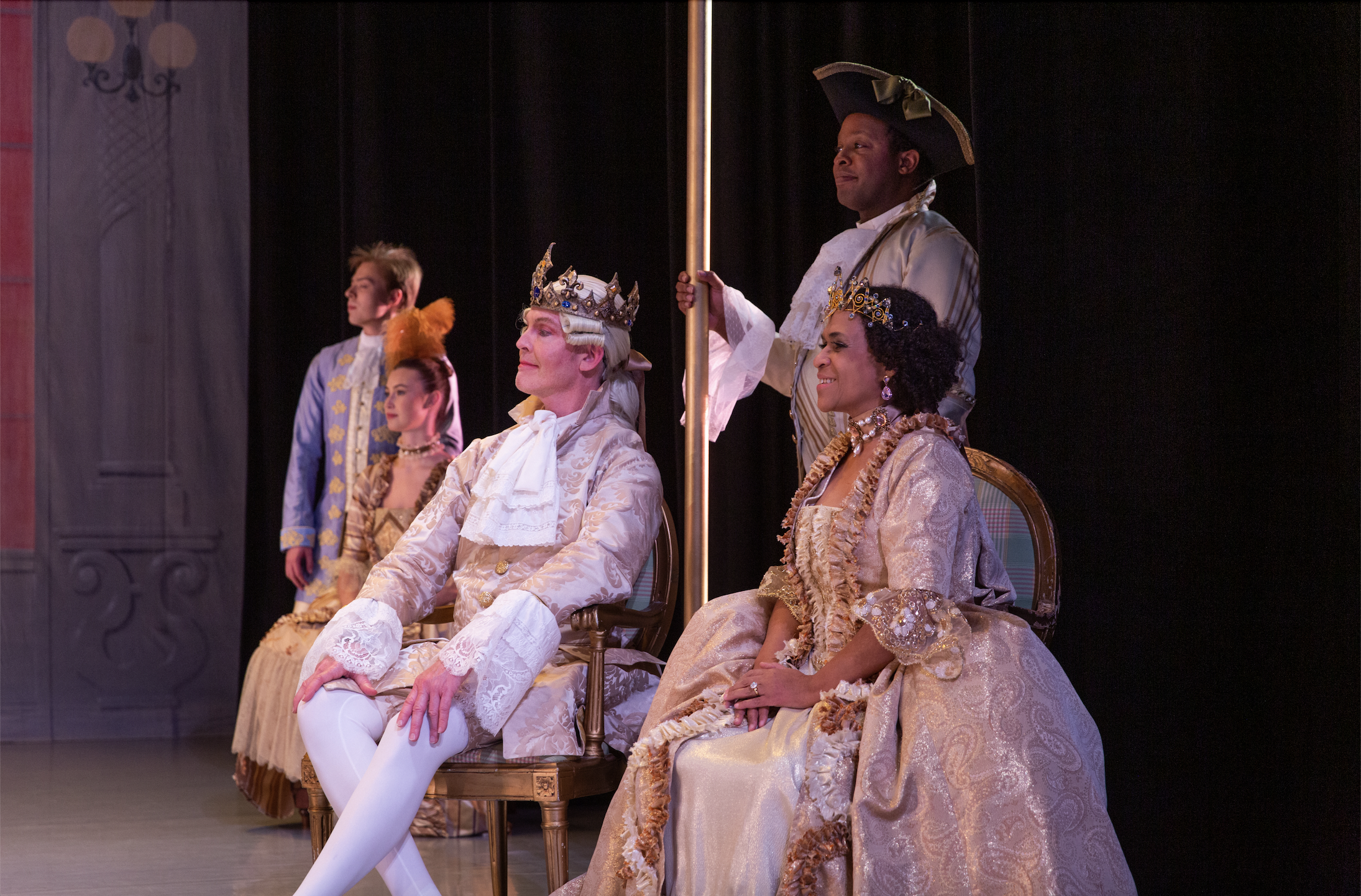 Christopher Alloways-Ramsey, Sean Carter, and Joselli Deans in "Sleeping Beauty," School of Dance Utah Ballet concert | photo Todd Collins
Christopher Alloways-Ramsey, Sean Carter, and Joselli Deans in "Sleeping Beauty," School of Dance Utah Ballet concert | photo Todd Collins
Fetzer: What impact do you feel like you specifically have in this equity work with organizations?
Deans: I think that I've put forward for them a history that they were unfamiliar with and added context it in a way that they needed to understand it — to understand the idea of Blacks and ballet.
When ballet started to develop itself in America, we were a segregated society. So white people had no idea what black people were doing. But Black people have been studying ballet as long as white people have. It's just nobody knew about it.
And then another comment that I make — particularly back then, not so much now because things have changed and evolved — but a lot of the people that taught Black dancers were Europeans because the white people wouldn't take them on. Europeans would teach them, many times, privately because they couldn't have the Black kids in the school. So they're not only getting European training, they're getting it privately. So the level of some of these dancers, these older dancers, was incredible. And then they opened schools, and they taught people. And then that generation of dancers got to dance in the 40s, 50s and the 60s.
Some went to Europe where they could have a career. Or they were in the Black ballet companies that were short lived in the 50s and the 60s until Mr. Mitchell started DTH in ‘69. I explain that we have documentation that Blacks were studying ballet since 1919.
I don't own Blacks in ballet, but I was one of the individuals who began really delving into it. Now that I'm in this position, in a Research 1 institution where I can do research, I have so many different projects in my brain. I am excited to start.
I think that I've put forward for them a history that they were unfamiliar with and added context it in a way that they needed to understand it — to understand the idea of Blacks and ballet.
Fetzer: What are some challenges that young dancers are facing today?
Deans: The arts have become a business model. It's all about the money. Now, don't get me wrong, we always needed money as artists. But the cost of living for you to dance — you could get two or three roommates and afford to live a decent life, and you can't do that anymore.
Young dancers have to be patient with themselves. They have to realize that although quantity seems to be what's important, both in money and in technique… for the people that really succeed, it's about quality. The quality of your choices, the quality of your dancing, the quality of life that you want to have. That's what gives you longevity. That's what gives you joy and satisfaction.
It's all about the tricks now, and that's not artistry. Artistry will take you into other places, and other levels. I was trained to be an artist. And that's why I can now be a dance historian and all the other things. It’s the level to which I was held –– it was about excellence.
FULL BIO
Joselli Audain Deans, originally from Brooklyn, NY, joined the Dance Theatre of Harlem after receiving most of her training at the company’s school. During her career with DTH she danced numerous roles, including “the accused as a child” in Agnes de Mille’s "Fall River Legend."
A scholar and an artist, she holds a doctorate in Dance Education from Temple University. Her dissertation entitled "Black Ballerinas Dancing on the Edge” documents the lives of Delores Browne and Raven Wilkinson and analyzes how biased ideas and practices impact African American ballet dancers, then and now. She has taught dance technique at Philadanco and several academic institutions including Bryn Mawr College and Temple University; presented her work at scholarly conferences, including at Corps de Ballet International, Association for the Study of African American Life and History, and Collegium for African Diaspora Dance; and her research is published on Arthur Mitchell’s archival collection on Columbia University’s library website curated by Lynn Garafola and in "(Re:) Claiming Ballet" edited by Adesola Akinleye. She has served as a consultant for several institutions and projects including for Dance Theatre of Harlem, American Ballet Theatre, New York City Ballet, School of American Ballet, San Francisco Ballet, Charlotte Ballet, the Dance Oral History Project for New York Public Library, the documentary "Black Ballerina," and was a design and facilitation team member for the Equity Project: Increasing the Presence of Blacks in Ballet.
Here comes Utah Ballet 2022!
University of Utah School of Dance presents “Utah Ballet,” featuring premiere works by guest artist and alumna Sayoko Knode and faculty artist Christine McMillan, plus a historical re-staging of the complete third act of Marius Petipa's “Sleeping Beauty,” by faculty artist Christopher Alloways-Ramsey.
Get ready to see pointe work three ways— one classical work, and two different flavors of contemporary work.
“Sleeping Beauty” is the pinnacle of the collaborative work between Marius Petipa, the 19th-century's most outstanding ballet choreographer, and Pyotr Ilyich Tchaikovsky, the greatest Romantic composer of the late 19th century.
“Sleeping Beauty represents the height of classical ideals in the refined technical challenges,” said Chris Alloways-Ramsey. “The harmonious balance Petipa creates within the patterns for the corps de ballet and the various divertissements create a spectacle that became Petipa's hallmark.”
Utah Ballet is presenting Act III of Sleeping Beauty which features the wedding celebration between Princess Aurora and Prince Désiré. The royal court, including the King and the Queen, are in attendance along with many of the characters from beloved fairy tales: Puss n' Boots, Red Riding Hood and the Wolf, the enchanted Princess Florine and the Bluebird, the Lilac Fairy, and Prince Florimund and his Sisters. Some of these characters will include our very own Sean Carter (SoD admin), Joselli Deans (SoD faculty), and Alloways-Ramsey himself.
“The Ballet Program dancers have grown artistically and technically through Petipa's challenging choreography and the hours of coaching that have brought this production to life” said Alloways-Ramsey.
“Becoming,” a new contemporary ballet choreographed by University of Utah alumna and guest artist, Sayoko Knode, introspects the often unspoken experiences that accompany many of life’s accomplishments.
“The piece is portrayed across musical compositions by Tchaikovsky, Saint-Saëns, and Dvorák,” said Knode. “It delves into the darker and bittersweet recognition that certain triumphs bring an end to one’s former self.”
The title of Christine McMillan’s new contemporary ballet piece, “Here we are/We are here,” invokes the concept that every moment is a new moment and embracing that. We can only be where we are at the present moment, and we can also pro-actively own the moment we are in.
"I seem to keep returning to the idea of vigilance/watchfulness within several of my works, and the constant effort in maintaining personal safety. This relates to the environment we find ourselves in, hence Here we are,” said McMillan. “I've also been thinking about the deep friendships I've built with various people over the years. Vigilance is tiring, and it’s easy to forget the sustenance we get from others. I’m interested in how we balance these aspects of our lives. The piece starts with this sense of vigilance, along with ideas of fierceness and drive to move forward. Within the piece, a trio embodies the literal and figurative support we get from one another. The final section furthers the journey of the dancers into a sense of confidence, comradery, and joy - embodying the assertiveness of the statement We are here."
Utah Ballet opens October 27th at the Marriott Center for Dance and is sure to be a dazzling display of movement utilizing both classical and contemporary pointe work.
Utah Ballet 2022
Oct 27 at 5:30 p.m. (in person or streamed online)
Oct 28 at 7:30 p.m. (in person or streamed online)
Oct 29 at 2 p.m. and 7:30 p.m. (in person or streamed online)
Nov 3 at 5:30 p.m. (in person only)
Nov 4 at 7:30 p.m. (in person only)
Nov 5 at 2 p.m. and 7:30 p.m. (in person only)
Free for University of Utah students with a valid UCard through the Arts Pass program!
Contemporary meets history in School of Dance season opener
Kicking off the 2022-23 season, the School of Dance presents “The School of Dance Concert,” showcasing premiere works by faculty artists Brent Schneider and Sara Pickett, along with the historical repertory works Fokine's “Les Sylphides,” staged by faculty member Maggie Wright Tesch, and “Songs of The Disinherited,” a classic work by Donald McKayle, restaged by Modern Dance MFA candidate, Irishia Hubbard.
The show brings together a mélange of flavors of the classical and contemporary, historical and modern day.
It takes a tremendous amount of coordination, time, and work to bring these historical pieces back to life in 2022. Contractual agreements with the historical legacies of Fokine and McKayle are in place to maintain the integrity of the legacy of the work as it is reconstructed on students in the School of Dance.
Donald McKayle’s “Songs of The Disinherited” is a work that reflects the African diaspora and the idea of coming to the new world restaged by current MFA candidate Irishia Hubbard.
“When I explain it to my students, I like to start by just the title, disinherited — and what that means, and thinking of those stories of people from my own culture whose voices and stories were not heard and how do we as performers and artists bring those stories back to the forefront,” said Hubbard.
“The students have invested so much in this process. I think it’s important not only for them to showcase the spectrum of work that they’re capable of doing, but also it’s important to bring black stories to the stage, and stories not just of black trauma, but of black liberation,” added Hubbard. (View the video below for a deeper look into the process.)
“The process for dancing “Les Sylphides” starts with asking permission from the Fokine estate which the School of Dance has been granted for the third time. The first time we had to send videos of our performances for them to okay us,” said Wright Tesch. “The piece appears to be of the romantic style but is actually one of the earliest neo-classical works and Fokine was strongly influenced by Isadora Duncan and the rise of modern dance. There is more movement from the waist and back than a typical romantic period piece.”
“This concert is especially rewarding as the clarity and variety of each choreographer’s vision is distinctly unique. Each time the curtain opens, the feel and atmosphere of the dance is uniquely its own,” said Brent Schneider, concert director and professor for the School of Dance. “The works showcased in this performance represent choreography from an expansive time span; Michel Fokine’s work was choreographed in 1909, Donald McKayle’s work in 1972, my work in 2000, and Sara Pickett’s work in 2022.”
Sara Pickett’s new piece "Skin + Bones” starts with the question, “What do you have?”
“By implication, the question requires consideration of what one does not have and what has been taken away,” said Pickett. “In these times, when a generation now has fewer bodily rights than the previous, we struggle for the path toward empowerment and, perhaps, joy,” she added.
Schneider’s work, “Excerpts from Life” features a mix of solos, duets, trios, and group sections seamlessly woven together to create a cohesive whole. “I took inspiration for the choreography from The People, Yes the longest and most complex poem Carl Sandburg ever wrote. Penned in 1936, the poem’s themes and imagery speak just as relevantly today as when the poem was written,” said Schneider. “The score for the work features lines from the poem in addition to an eclectic mix of musical scores, both classical and contemporary.”
The School of Dance concert opens Sept. 29, at the Marriott Center for Dance. Don’t miss your chance to see an incredibly powerful and historically important evening of dance.
The Details
The School of Dance Concert runs for two weeks. Showtimes in the Marriott Center for Dance are:
Sept 29 at 5:30 p.m. (live performance streamed online)
Sept 30 at 7:30 p.m. (live performance streamed online)
Oct 1 at 2 p.m. and 7:30 p.m. (live performance streamed online)
Oct 6 at 5:30 p.m.
Oct 7 at 7:30 p.m.
Oct 8 at 2 p.m. and 7:30 p.m.
The School of Dance Concert will be live-streamed on these dates ONLY at dance.utah.edu/virtualshows
Sept 29 @ 5:30pm | Sept 30 @ 7:30pm | Oct 1 @ 2:00pm and 7:30pm
In-person tickets can be purchased at tickets.utah.edu for all dates
Free for University of Utah students with a valid UCard through the Arts Pass program
Patrons can also stream the first week of performances live for free
Six dancers. One choreographer. Five days in Utah's wild landscapes.
"Traverse," a film screening and live performance presented by TWIG Media Lab, originated in 2016 when Chris Lee, then an adjunct professor in the U Department of Film & Media Arts, approached the Department’s chair, Kevin Hanson. Hanson was excited by the project and took the lead (along with Associate Professor Connie Wilkerson and Associate Professor in the U School of Dance Eric Handman) on securing a Dee Grant that provided travel and production expenses.
The vision was to film dancers exploring diverse biomes across Utah, letting choreography be inspired by the textures and images found there. The result would be part documentary and part art film. Handman recommended Nick Blaylock as choreographer, a student in the graduate modern dance program. Blaylock assembled a cast of dancers to join.
They were strategic in planning their journey in a loop, with nearby towns at each stop along the way. Chris and Alex Lee had tackled filming on remote location before and had camped the entire duration, which created challenges. “The most difficult thing about being out on the road is having the ability to be able to recharge and offload media at the end of the day in somewhat of a controlled environment.”
First, the group traveled to Ibex Well where they encountered rugged desert. Next, the high alpine terrain of Tushar Mountains. Then the dreamy Coral Pink Sand Dunes, followed by Capitol Reef, Goblin Valley, and culminating in Moab. All along the way they danced in response to what they saw and felt.
The project was so informed by space that retracing memories takes you right back to the texture of the cracked earth from one location, to the fluid sand at another, and the feeling of scrubbing off the dirt after a long exhausting day yet being so full from work we created.
-Samantha Matsukawa, dancer
During the process, the University of Utah community was watching from afar. The School of Dance shared small clips to a broad audience of social media followers, and the U posted the group’s progress on the website homepage. It was exciting for the community to feel like they were watching the piece unfold.
Once completed, TWIG knew they wanted to show the film with a live performance all along. Such a show was scheduled for March 2020 when all performances were cancelled or rescheduled due to COVID-19. But now the moment has come.
Since the filming of the project several years ago, the dancers and production team (a majority of whom are College of Fine Arts alums!) have all spread out across the world. But for Blaylock (MFA ‘17), and dancers Samantha Matsukawa (BA, BFA ‘14) and Eliza Tappan (BFA ‘16), it will be an exciting reunion – a chance to revisit what they made and share it with some new performers. It’s an opportunity not many artists get after a project wraps.
“There are alot of questions that it brought up for me,” Chris said. “For example, particularly when you are getting ready to leave college, how will you continue to have dance in your life? What does dance mean? What does it mean now, years later? What emotions does it bring up?”
Looking back, Matsukawa has vivid recollections of 'Traverse.' “The project was so informed by space that retracing memories takes you right back to the texture of the cracked earth from one location, to the fluid sand at another, and the feeling of scrubbing off the dirt after a long exhausting day yet being so full from work we created,” she said.
Blaylock had similar thoughts. “I think about Hoodoo creatures, sunset dances in ash mountains, explosions of pink sand, and friction burns from the salt flats.”
Above all, they remember that being together was the best part. “Everyone had a lighthearted approach to the travel and inherent time crunch, as well as a reverent zeal when arriving at the locations,” Blaylock recalled. “They were so interested in each environment and cared about honoring the landscape with their efforts. Their relationship to the project and to each space was inspiring.”
Traverse
Friday, July 1
7:00 PM
Rose Wagner Performing Arts Center
Jeanné Wagner Theatre
Get Tickets
Cast
Nick Blaylock, choreographer
Maddie Andersen
Micah Burkhardt
Brianna Lopez
Samantha Matsukawa
John Sotele
Eliza Tappan
Film Crew
Chris Lee, director
Alex Lee, director of photography
Adam Essig
Karem Orrego
July 1 Cast/Performers -
Nick Blaylock, choreographer
Olivia Beck
Natalie Border
Samantha Matsukawa
Megan O'Brien
Eliza Tappan
Bashaun Williams
The College of Fine Arts is delighted to present the 2022 Outstanding Seniors from each of our five academic units. These individuals were nominated for their academic achievements, artistic and scholarly accomplishments, and ongoing commitment to their craft. We are inspired by each of them, and look forward to witnessing the ways they continue to contribute to our community. We are honored to have shared their time here as students.
Congratulations!
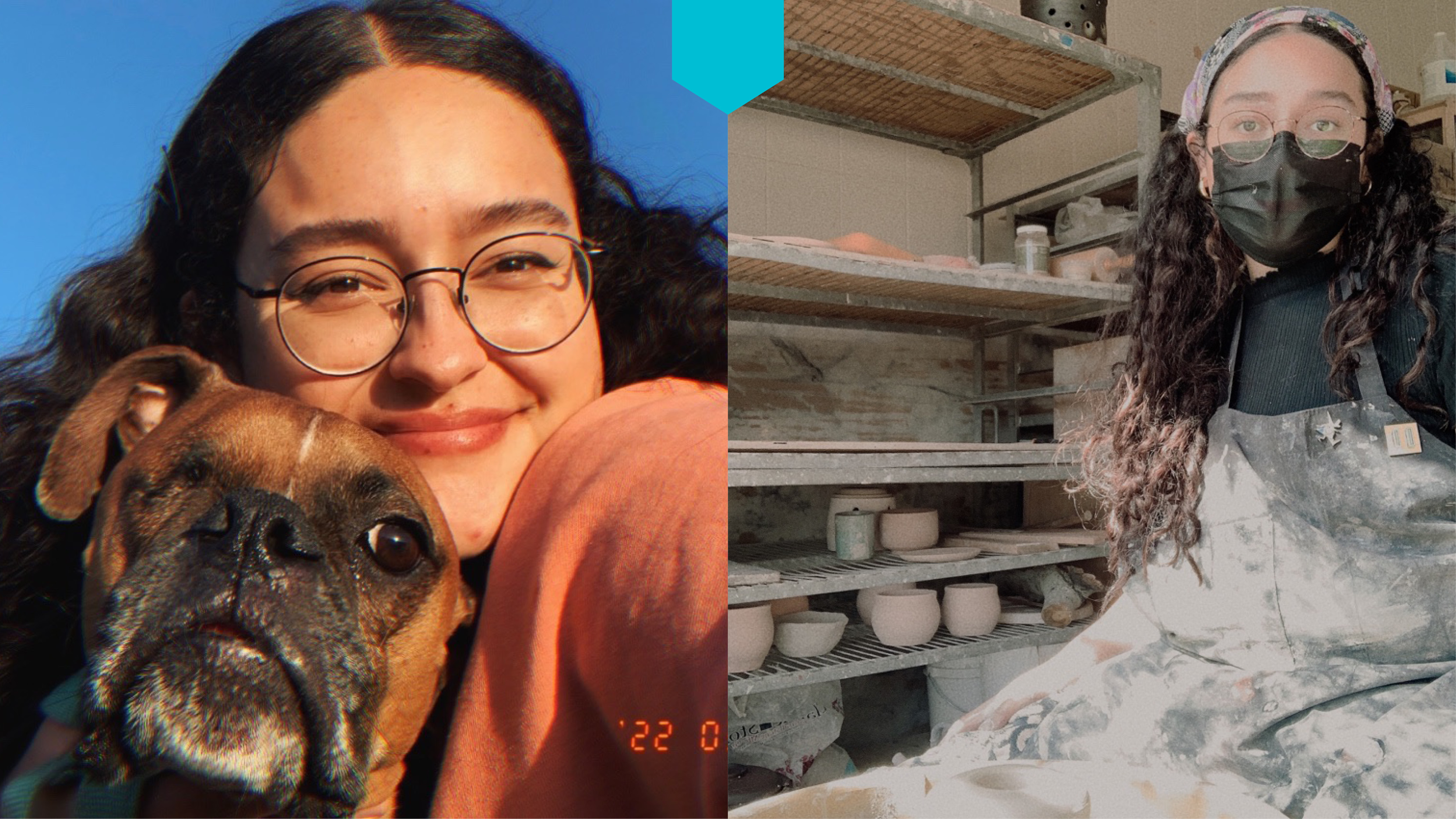 Alexandria Jensen
Alexandria Jensen
Department of Art & Art History
Pronouns: She/Her
Majored in: Art Teaching with K-12 Licensure
Hometown: Salt Lake City
Three words that describe you: Kind, Passionate, Creative
Most impactful class or professor: Beth Krensky really encouraged and inspired me throughout my time in the College of Fine Arts. The kindness and care that she radiates to all of her students is so important, and her passion for art education further reinforced my choice to be an art educator.
A CFA moment you’ll never forget: I really loved all of my studio courses throughout my time at the CFA. I was able to learn about and explore so many different mediums and develop a newfound passion for ceramics. I am really grateful to all my professors who encouraged me!
What inspires you: My students inspire me. Seeing them make discoveries and breakthroughs when exploring different artistic processes always inspires me to create and explore with my own artwork.
Summary of major accomplishments on or off campus: I have accepted a position as the ceramics teacher at a school in the community I have been working with youth in for five years.

Fiona Thomas
School of Dance
Pronouns: she/her/hers
Majored in: BFA in Modern Dance, Minor in Entrepreneurship
Hometown: Seattle, WA
Three words that describe you: passionate, curious, tenderhearted
Most impactful class or professor: It feels impossible to choose the most impactful class or professor because each one has been such a tremendous part of my journey. I will say that Contemporary Views was the first class that helped me acknowledge my fears and accomplishments simultaneously. Understanding my worth and passion as an artist is the most valuable thing I have gained as a student.
A CFA moment you’ll never forget: When I sang for Satu and Daniel's piece in the Fall Show, called 'remember everything that spring can bring (2020 Ballads)'
What inspires you: Being around others that care deeply about something, and knowing that art can make change.
Summary of major accomplishments on or off campus:
- Volunteered with Healing in Motion Dance in 2018 and 2019
- Taught creative dance to youth at the Utah Refugee Center at the Meadowbrook Campus site in 2019 and 2020
- During Covid, Fiona was based in Seattle and taught a variety of classes remotely at All That Dance and at Olympic Hills, a local elementary school
- Fiona has been a part of faculty works with Eric Handman and Daniel Clifton as well as Graduate Thesis works with Alexandra Barbier and Jessica Boone"
- Created a collaborative work with Lia Wong to be premiered at the Spring Student Concert in February of 2020
- Fiona has been in numerous works by fellow peers and classmates in Senior shows, Student Concerts, and Graduate shows
- Served on student concert committee in 2020 and 2021
- Choreographed and performed a solo this spring that her and Daniel Clifton co-created the music for, titled 'To wonder is to live. And I am the wolf'
- This semester, Fiona is interning with Heartland, a collective directed by Molly Heller
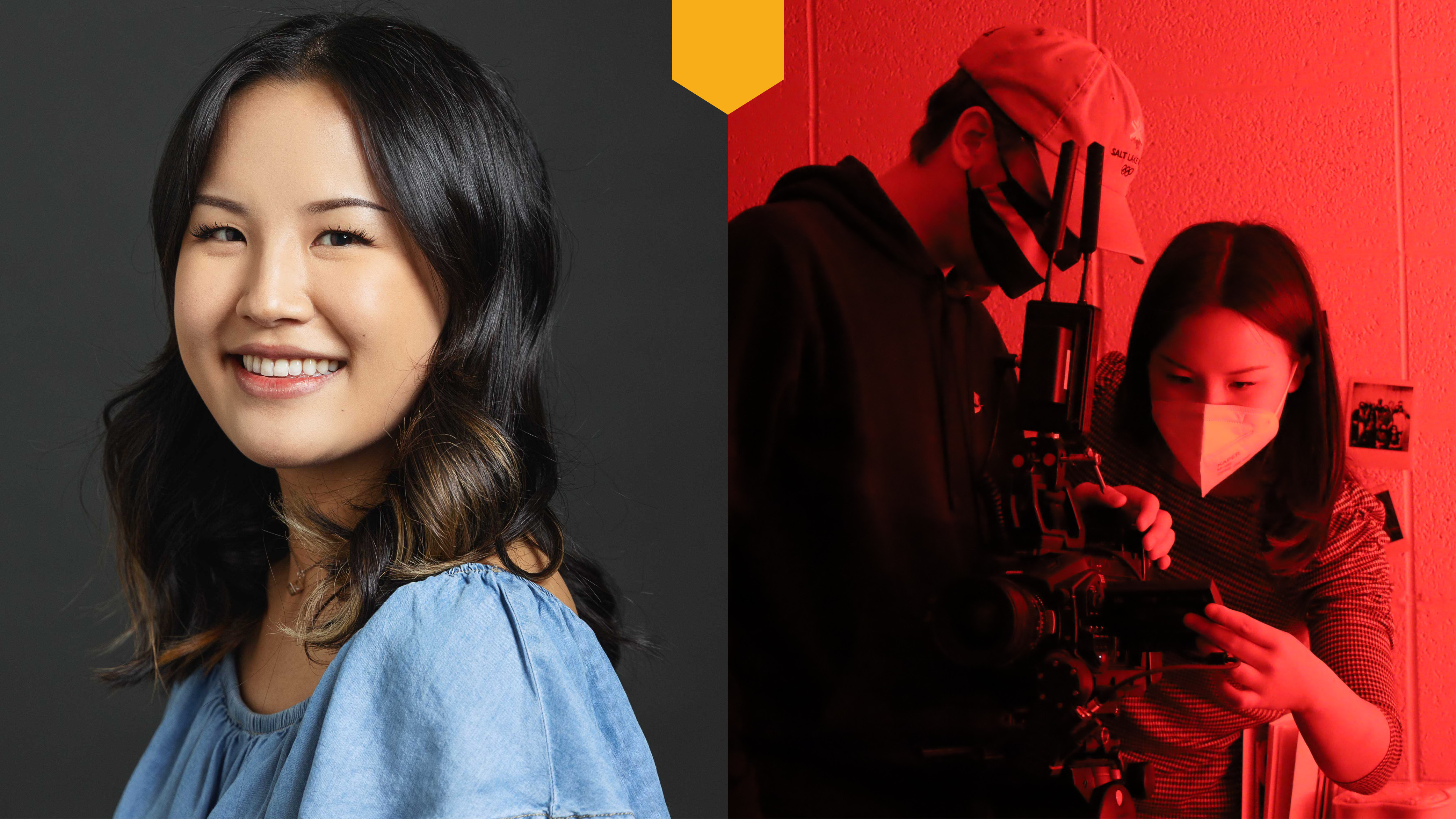
Yein Ji
Department of Film & Media Arts
Pronouns: She/Her/Hers
Majored in: Film & Media Arts BFA
Hometown: North Salt Lake
Three words that describe you: Dependable, Intuitive, Ambitious
Most impactful class or professor: Sonia & Miriam Albert-Sobrino. They are always full of energy and passion for filmmaking. They always make me laugh and they’re incredibly knowledgeable. Everyone in the film department knows how amazing these women are. They inspire me to work harder and create beautiful art.
A CFA moment you’ll never forget: The F&MAD Festival last spring. I got to watch and celebrate the films made by me and my talented friends.
What inspires you: My family. They’ve always been supportive of everything I do. They’ve starred in some of my film projects and are always excited for my next creation.
Summary of major accomplishments on or off-campus:
- Vice President of Film Production Club
- 2021 Queer Spectra Arts Festival Intern
- 2 Semesters of Undergraduate Research
- Pretty Girl film published in Undergraduate Literary Magazine
- Cheers films showcased at Utah Arts Festival
- Helped create 34 films
- Directed 8 films
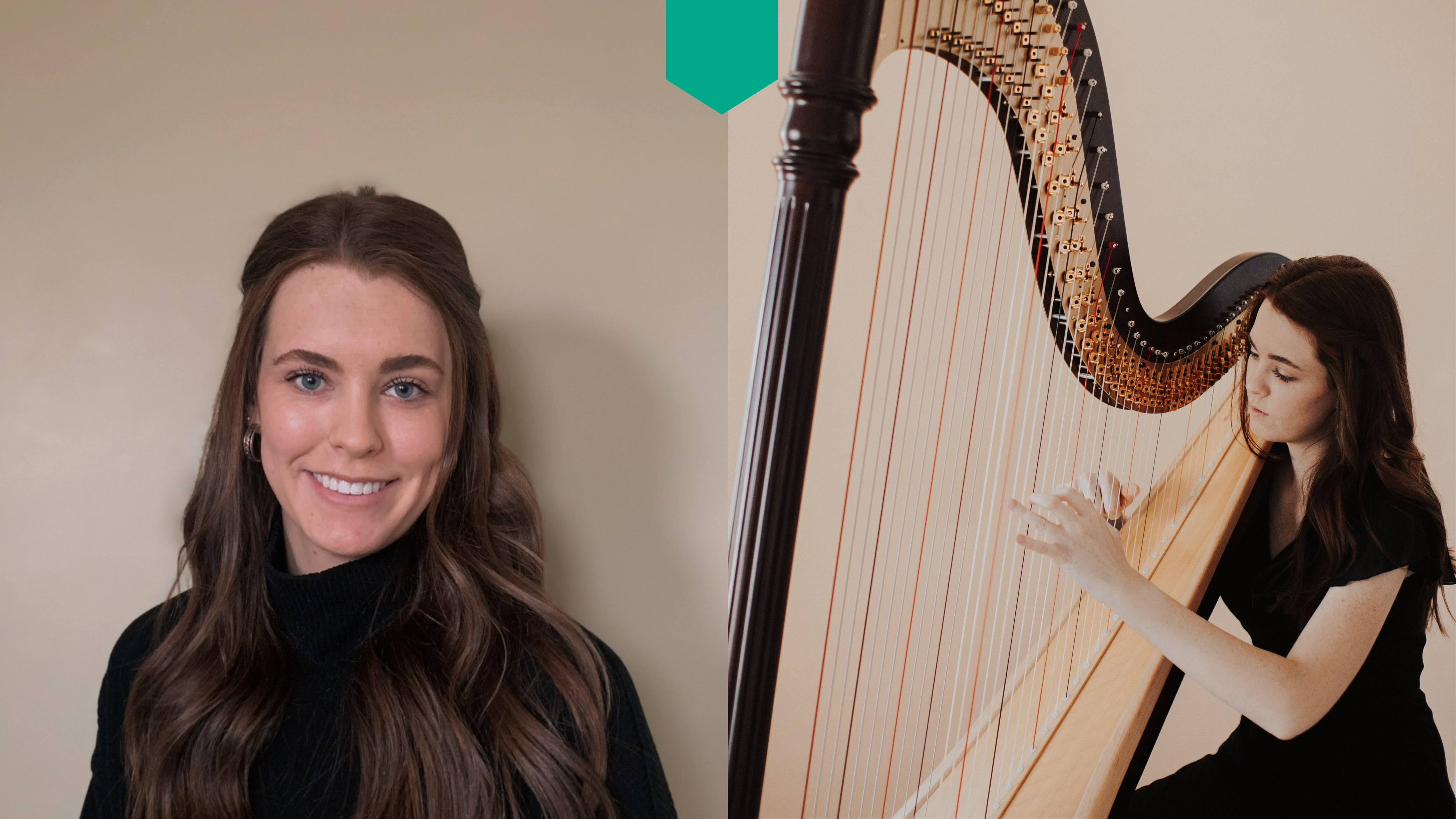
Merinda Christensen
School of Music
Pronouns: she/her/hers
Majored in: Instrumental Performance - Harp
Hometown: West Bountiful, UT
Three words that describe you: Outgoing, Ambitious, Compassionate
Most impactful class or professor: Dr. Cathy Clayton. Cathy has been my private harp instructor over the last 4 years and welcomed me with open arms when I made my transfer from the University of Arizona to Utah. She has always been so supportive as I have found my career path and I’m grateful for the time I’ve been able to spend studying under her while here at the U.
A CFA moment you’ll never forget: I had the most amazing opportunity to be an Emerging Leaders Intern for ArtsForce in the CFA that has really prepared and paved a path for me as I continue on with my career after graduation. The friendships and connections made while a part of ArtsForce is something I will always cherish after leaving the College of Fine Arts.
What inspires you: I’m inspired by people that are passionate about what they do and work hard to accomplish their goals.
Summary of major accomplishments on or off campus:
- President for the School of Music Harp Ensemble: Harps at the U of U 2019 - 2022
- ArtsForce intern for the CFA 2020 - 2021
- Awarded Internship of the Year with ArtsForce from the Career and Professional Development Center 2021
- First recipient of the Music Entrepreneurship Certificate from the University of Utah School of Music 2022
- Marketing and Communications intern for UtahPresents at Kingsbury Hall 2021 - 2022
- Event Chair and summer intern for Women’s Artistic Leadership Initiative 2020 - 2021
- Crimson Mentor for transfer students at the University of Utah 2020 - 2021
- Carmen Morton Christensen scholarship recipient 2018 - 2022
- Program Assistant for THE BLOCKS: organization under the Downtown Alliance and SLC Chamber of Commerce, offered through my internship with ArtsForce
- Director of Development for Opera Mississippi, offered through connections made while completing the Music Entrepreneurship Certificate
Danny Borba
Department of Theatre
Pronouns: he/him/el
Majored in: Bachelor of Fine Arts, Emphasis: Actor Training Program; Minor: Ethnic Studies
Hometown: Orem, Ut
Three words that describe you: Respectful, Determined, Outgoing
Most impactful class or professor : This one is a hard one! So I am mentioning a couple of things:
Andra Harbold and her wisdom regarding directing has been something that continues to bring so much joy and light into my journey as an artist and a human.
Robert Scott Smith always pushes me to be better and innovate with the art.
Nathan Brian’s belief in me as a vocalist and an artist has helped me push through tough times.
Jerry Gardner has brought me peace and inspiration through Butoh and through my interactions with him.
Sarah Shippobotham amazes me continuously with the knowledge she imparts through Shakespeare or Dialects or text work.
All of these professors and mentors (and plenty more) have pushed me to better, while also believed in me as an individual, and have encouraged me to make the theatre arts a place of inclusion and innovation. I will forever be grateful.
A CFA moment you’ll never forget: My first ArtsBash, about 4 years ago. It was the first time performing as a U of U students, and also the first time seeing how wonderfully diverse and big the College is!
What inspires you: In a specific example, Viola Davis’ journey as an artist and a human has always given comfort and inspiration. But I also want to think about my family and God. Their support and their own stories have been critical in my growth as an artist, but also as a human being. Without them, and I mean ALL of them, I would not be who I am today, or doing what I do.
Summary of major accomplishments on or off campus: Not going to lie, being a part of High School Musical: The Musical: The Series was pretty amazing, and being able to intern at Pioneer Theatre was a major goal accomplished, but one thing that stands out was being able to create a BIPOC community with my friends and establish that we belong here and aren’t going anywhere has been a very important thing for me.
Performing Sondheim’s “Sweeney Todd” with the University of Utah opera program has been a long-held aspiration for director Robert Breault. Beyond its cultural popularity, moody environment, and complex characters, the show allows for broad collaboration and interdisciplinary participation.
“I always try to choose pieces that will allow [U Opera] to include as many students as we can. ‘Sweeney’ has a lot of ensemble work that allows more performers to be part of the storytelling – there are about 40 of us involved,” Breault said.
To pull off the mighty production that runs this weekend (April 15-16) at Kingsbury Hall, collaborators from all corners of the U’s performing arts units have come together, embracing the idea that “it takes a village.”
The cast is made up of not just opera students, but those in musical theatre and dance as well. Logistics will be run by Stage Management students in Department of Theatre, led by Amber Bielinski. Music director Jeffrey Price also directed the music in the first Utah production of Sweeney 40 years ago – and was the first to plant the idea of doing the production at the U. The Utah Philharmonia, conducted by School of Music professor Robert Baldwin, provides the score.
It is especially exciting to see faculty from each of the performing arts units lending their particular expertise to elevate the production. School of Dance’s Melissa Bobick brings her ballet eye as choreographer. Department of Theatre’s Sarah Shippobotham serves as both Intimacy Director and as a dialogue coach.
"The idea that we can have this interdisciplinary cooperation in one production mirrors the way it will be in the real world. Stage management, singers, dancers…we all get to know each other, and realize how it all works together."
After an already extensive singing career, James Bobick, who plays the titular role, is pursuing his MM in the School of Music. Working in this way, he says, is an authentic glimpse at how the professional world operates.
“This is about training young musicians, singers, and performers. Whether they become professionals or not, they can use this skill set as they move on in their life and in their careers," he said. “The idea that we can have this interdisciplinary cooperation in one production mirrors the way it will be in the real world. Stage management, singers, dancers…we all get to know each other, and realize how it all works together.”
Although musical theatre and opera often vary quite a bit stylistically, “Sweeney Todd” has been an opportunity for the two disciplines to learn from one another, and get stronger as a result. “The musical theatre students are getting a chance to hear how we sing, and we are learning from their acting,” Breault explained. “We’re singing with mics for the first time, and we aren’t using supertitles. I did this purposely to put the pressure on all of us to improve our diction.”
Undergraduate senior Brynn Staker, who plays Beggar Woman, also spoke to how the character’s dramatic needs were affecting her singing approach. “The accent work has been tricky,” she said. A lot of times when you are singing, your vowels tend to sit in the same place. In this, it’s been different because accents communicate class differences. We’ve had to work to get a brighter sound to convey the same things the accent would convey while we sing.”
There is quite a bit of character work necessary to bring this dramatic tale of revenge home.
“Sweeney is, like the great operatic characters, complicated, and has more levels of his personality than most people give him credit for,” Bobick said. “This is a real man, with real problems, and real conflict. And as he seeks to resolve them, it’s not a spontaneous impulse – this is fifteen years of brooding over injustice. Fifteen years he has tried to figure out how he can avenge the wrong done to him and his family.”
Staker agreed that the story allows for deeper performance. “I feel like in opera we put on a mask a lot – we sing big words with big sound,” she said.” This show gives us a chance to portray real people in real situations, and allow the audience to connect with them on a vulnerable and intimate level."
Ultimately for Breault, the best thing about "Sweeney Todd" is coming back together after two full years of missing the stage – another reason to more fully embrace collaboration.
"It’s been over two years since we have had the family feeling in the Voice Box that we had before the pandemic. To have everybody hanging out, to see people spontaneously dancing while working on scenes – I see the joy of finally coming together again. This has been so fun for me as a director."

